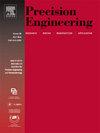基于CFD的气垫节流结构对磨床支撑性能的影响
IF 3.7
2区 工程技术
Q2 ENGINEERING, MANUFACTURING
Precision Engineering-Journal of the International Societies for Precision Engineering and Nanotechnology
Pub Date : 2025-05-15
DOI:10.1016/j.precisioneng.2025.05.010
引用次数: 0
摘要
作为生产过程过渡的关键部件,高端磨床输送系统的支撑稳定性对晶圆片的表面质量有着重要的影响。为了保证换位系统在大载荷、大浮量下的稳定性,提出了一种细孔气静压支撑的气垫结构。基于计算流体动力学(CFD),分析了传统节流孔、细长节流孔、圆柱腔和方腔节流对气垫压力分布和流场特性的影响,确定了细长节流孔结构的优越性能。进一步讨论了节流孔直径、节流孔数、节流孔长径比等结构因素对气垫性能和浮驱的影响。结果表明:当膜厚为34 μm时,细长孔的承载力是小孔的7.28倍,刚度是小孔的3.28倍;对于细长孔,载荷能力与节流孔直径和节流孔数呈正相关,而刚度与节流孔直径和节流孔数呈负相关。长径比对承载能力和刚度的影响可以忽略不计。在此基础上,制作了孔径为1mm的陶瓷支撑气垫,并进行了浮动位移测量。在约1000 kg的载荷下,气垫的升力超过20 μm,从而验证了其支撑性能。与计算结果相比,最大误差小于5.96%。研究结果为设计大浮量条件下的高承载刚度气垫提供了理论依据和数据依据。本文章由计算机程序翻译,如有差异,请以英文原文为准。
Influence of air cushion throttling structure on support performance of grinding machine based on CFD
As a critical component in the transition of production processes, the support stability of the transport system in the high-end grinding machines significantly impacts the surface quality of the wafer. To guarantee the stability of the transposition system under heavy loads and large floating volumes, an air cushion structure supported by aerostatic pressure with slender holes is proposed. Based on Computational Fluid Dynamics (CFD), the effects of traditional orifices, slender orifices, cylindrical cavity, and square cavity throttling on the air cushion pressure distribution and flow field characteristics were analyzed, determining the superior performance of the slender orifice structure. Furthermore, the influence of structural factors, including throttling hole diameter, number and length-diameter ratio, on air cushion performance and floating displacement is discussed. The findings indicate that, at a film thickness of 34 μm, the slender hole exhibits a bearing capacity 7.28 times higher than that of the small hole, accompanied by a stiffness that is 3.28 times increased. Moreover, for slender holes, a positive correlation is observed between the load capacity and both the diameter and the number of throttling holes, while stiffness is negatively correlated with these parameters. The length-diameter ratio has a negligible influence on both load capacity and stiffness. Building on the above findings, a ceramic-supported air cushion with an orifice diameter of 1 mm was fabricated, and floating displacement measurements were conducted. Under a load of approximately 1000 kg, the air cushion lift exceeded 20 μm, thereby validating its supporting performance. The maximum error compared to the calculated results was less than 5.96 %. The results of the research offer both theoretical underpinning and data evidence for designing air cushions with high bearing capacity and stiffness under conditions of large floating volumes.
求助全文
通过发布文献求助,成功后即可免费获取论文全文。
去求助
来源期刊
CiteScore
7.40
自引率
5.60%
发文量
177
审稿时长
46 days
期刊介绍:
Precision Engineering - Journal of the International Societies for Precision Engineering and Nanotechnology is devoted to the multidisciplinary study and practice of high accuracy engineering, metrology, and manufacturing. The journal takes an integrated approach to all subjects related to research, design, manufacture, performance validation, and application of high precision machines, instruments, and components, including fundamental and applied research and development in manufacturing processes, fabrication technology, and advanced measurement science. The scope includes precision-engineered systems and supporting metrology over the full range of length scales, from atom-based nanotechnology and advanced lithographic technology to large-scale systems, including optical and radio telescopes and macrometrology.

 求助内容:
求助内容: 应助结果提醒方式:
应助结果提醒方式:


